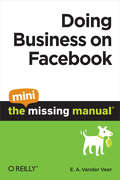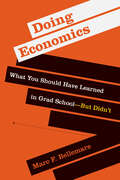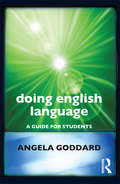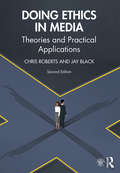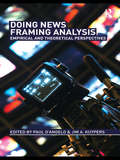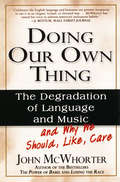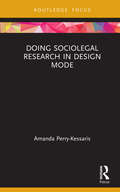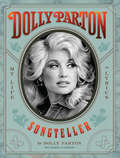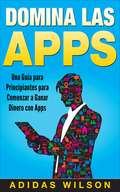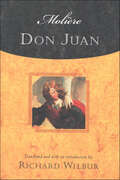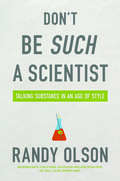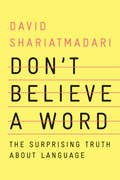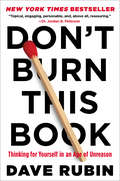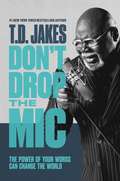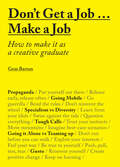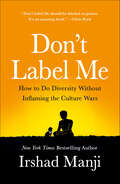- Table View
- List View
Doing Business on Facebook: The Mini Missing Manual
by E. A. Vander VeerFacebook isn't just for college kids anymore. Thousands of companies use the site for everything from project collaboration and advertising to filling--and finding--jobs. This Mini Missing Manual is aimed at professionals who want to use Facebook to help them in the work world. Whether you're looking for a gig or want to boost your company's sales, you'll find useful tips you can apply today.
Doing Economics: What You Should Have Learned in Grad School—But Didn’t
by Marc F. BellemareA guide for research economists: how to write papers, give talks, navigate the peer-review process, advise students, and more.Newly minted research economists are equipped with a PhD&’s worth of technical and scientific expertise but often lack some of the practical tools necessary for &“doing economics.&” With this book, economics professor Marc Bellemare breaks down the components of doing research economics and examines each in turn: communicating your research findings in a paper; presenting your findings to other researchers by giving a talk; submitting your paper to a peer-reviewed journal; funding your research program through grants (necessary more often than not for all social scientists); knowing what kind of professional service opportunities to pursue; and advising PhD, master&’s, and undergraduate students. With increasing data availability and decreasing computational costs, economics has taken an empirical turn in recent decades. Academic economics is no longer the domain only of the theoretical; many young economists choose applied fields when the time comes to specialize. Yet there is no manual for surviving and thriving as a professional research economist. Doing Economics fills that gap, offering an essential guide for research economists at any stage of their careers.
Doing English Language: A Guide for Students (Doing... Series)
by Angela GoddardDoing English Language provides a concise, lively and accessible introduction to the field of English Language studies for readers who are interested in taking courses at university level. This book addresses the fundamental questions about studying English Language, including: How is English Language studied and researched? Which subject areas does English Language draw on? How are different topics approached? How is the study of English Language relevant to real world contexts? What careers can English Language lead to? Written by an experienced teacher, researcher, and examiner, Doing English Language is both an essential guide for students at pre-university stage and a course companion for undergraduates choosing options within a degree programme.
Doing Ethics in Media: Theories and Practical Applications
by Chris Roberts Jay BlackThe second edition of Doing Ethics in Media continues its mission of providing an accessible but comprehensive introduction to media ethics, with a grounding in moral philosophy, to help students think clearly and systematically about dilemmas in the rapidly changing media environment. Each chapter highlights specific considerations, cases, and practical applications for the fields of journalism, advertising, digital media, entertainment, public relations, and social media. Six fundamental decision-making questions—the "5Ws and H" around which the book is organized—provide a path for students to articulate the issues, understand applicable law and ethics codes, consider the needs of stakeholders, work through conflicting values, integrate philosophic principles, and pose a "test of publicity." Students are challenged to be active ethical thinkers through the authors’ reader-friendly style and use of critical early-career examples. While most people will change careers several times during their lives, all of us are life-long media consumers, and Doing Ethics in Media prepares readers for that task. Doing Ethics in Media is aimed at undergraduate and graduate students studying media ethics in mass media, journalism, and media studies. It also serves students in rhetoric, popular culture, communication studies, and interdisciplinary social sciences. The book’s companion website—doingethicsin.media, or www.doingmediaethics.com—provides continuously updated real-world media ethics examples and collections of essays from experts and students. The site also hosts ancillary materials for students and for instructors, including a test bank and instructor’s manual.
Doing Interview-Based Qualitative Research
by Jeanne Marecek Eva Magnusson Magnusson, Eva and Marecek, JeanneFor many students, the experience of learning about and using qualitative methods can be bewildering. This book is an accessible step-by-step guide to conducting interview-based qualitative research projects. The authors discuss the 'hows' and 'whys' of qualitative research, showing readers the practices as well as the principles behind them. The book first describes how to formulate research questions suited to qualitative inquiry. It then discusses in detail how to select and invite research participants into a study and how to design and carry out good interviews. It next presents several ways to analyze interviews and provides readers with many worked examples of analyses. It also discusses how to synthesize findings and how to present them. Doing Interview-based Qualitative Research equips readers in disciplines such as psychology, sociology, education, counseling, nursing, and public health with the knowledge and skills necessary to embark on their own projects.
Doing News Framing Analysis II: Empirical and Theoretical Perspectives
by Paul D'AngeloThis volume presents original, ‘big picture’ perspectives on news framing. Each chapter in this volume will feature an individual or team of framing analysts who take a reflective look at their own empirical work. The editors' goals are to identify the influences that determine the use of different theoretical and methodological approaches, and to provide interpretive guides to news framing scholars regarding what news frames are, how they can be observed in news texts, and how framing effects are uncovered and substantiated in cultural, group, and individual sites. Doing News Framing Analysis II will continue the work of its predecessor by giving talented framing scholars the space to write about their work and bring readers closer to the framing research project.
Doing News Framing Analysis: Empirical and Theoretical Perspectives
by Jim A. Kuypers Paul D'AngeloDoing News Framing Analysis provides an interpretive guide to news frames – what they are, how they can be observed in news texts, and how framing effects are uncovered and substantiated in cultural, group, and individual sites. Chapters feature framing analysts reflecting on their own empirical work in research, classroom, and public settings to address specific aspects of framing analysis. Taken together, the collection covers the full range of ways in which framing has been theorized and applied—across topics, sources, mechanisms, and effects. This volume fosters understanding among the scholarly camps of framing scholars, and encourages greater clarity from framing analysts in all aspects of their empirical inquiry. Chapters offer fresh perspectives from which researchers can begin new research programs, puzzle through perplexing problems in a current research program, or expand an existing program. Providing conceptual and methodological guidance, Doing News Framing Analysis will help framing researchers at all levels to better understand news framing and to improve their future news framing research.
Doing Our Own Thing: The Degradation of Language and Music and Why We Should, Like, Care
by John McWhorterEncourages readers to establish a boundary between an acceptable evolution of language and outright language misuse, predicting the consequences of the overuse of street English in today's writing, music, and society. By the author of The Power of Babel. 50,000 first printing.
Doing Sociolegal Research in Design Mode
by Amanda Perry-KessarisThis book is the first to explore what design can do for sociolegal research. It argues that designerly ways—mindsets that are practical, critical and imaginative, experimental processes and visible and tangible communication strategies—can be combined to generate potentially enabling ecosystems; and that within these ecosystems the abilities of a researcher to make meaningful contributions and to engage in meaningful research relations, both within our research community and in the wider world, can be enhanced. It is grounded in richly illustrated examples of sociolegal researchers working in design mode, including original individual and collaborative experiments involving a total of over 200 researchers; and of experts from subfields such as social design, policy design, and speculative design working on issues of sociolegal concern. It closes with an opening: a set of accessible sociolegal design briefs on which the impatient can make an immediate start. Written by an experienced sociolegal researcher with formal training in graphic design, the book is primarily focused on what the sociolegal research community can take from design, but it also offers lessons to designers, especially those who work with law.
Dolly Parton, Songteller: My Life in Lyrics
by Robert K. Oermann Dolly PartonDolly Parton, Songteller: My Life in Lyrics is a landmark celebration of the remarkable life and career of a country music and pop culture legend.As told by Dolly Parton in her own inimitable words, explore the songs that have defined her journey. Illustrated throughout with previously unpublished images from Dolly Parton's personal and business archives.Mining over 60 years of songwriting, Dolly Parton highlights 175 of her songs and brings readers behind the lyrics.• Packed with never-before-seen photographs and classic memorabilia• Explores personal stories, candid insights, and myriad memories behind the songsDolly Parton, Songteller: My Life in Lyrics reveals the stories and memories that have made Dolly a beloved icon across generations, genders, and social and international boundaries. Containing rare photos and memorabilia from Parton's archives, this book is a show-stopping must-have for every Dolly Parton fan.• Learn the history behind classic Parton songs like "Jolene," "9 to 5," "I Will Always Love You," and more.• The perfect gift for Dolly Parton fans (everyone loves Dolly!) as well as lovers of music history and countryAdd it to the shelf with books like Coat of Many Colors by Dolly Parton, The Beatles Anthology by The Beatles, and Born to Run by Bruce Springsteen.
Domina Las Apps: Una Guía para Principiantes para Comenzar a Ganar Dinero con Apps
by Adidas WilsonLas teconlogías de la comunicación avanzan constatemente para adaptarse a los tiempos. Las apps de mensajes son algo enorme ahora. Han superdo completamente a las redes sociales al convertirse en nuestra forma primaria de comunicación. Cuando la mayoría de los empresarios inician, les gusta leer artículos sobre "cómo arrasar con tu primer app," "contruyendo la app de mil millones de dólares" y muchos libros relcionados a este tema. Están pegados a este lado de la historia y cegados al otro. A fin de tener tu propia historia de éxito, debes descubrir por qué otras apps fallan. La dolorosa verdad es que hay más app fallidas que apps exitosas.
Dominando el Podcasting: Cómo iniciar, hacer crecer y monetizar tu podcast
by Adidas WilsonUn podcast es, básicamente, algo parecido a una radio online. La única diferencia es que presenta ciertas ventajas, como la posibilidad de escucharlo cuando lo desees en lugar de tener que hacerlo en un determinado día u horario. Si bien los podcasts se parecen a los programas de entrevistas de la radio, son al mismo tiempo muy diferentes, como sucede con los videos de YouTube y la televisión. Un podcast se describe mejor como una serie de episodios almacenados en archivos de audio, del mismo tipo de los que usas para escuchar música en tu smartphone o en tu computadora . Al igual que cualquier otro programa de entrevistas de radio o televisión, un podcast generalmente trata sobre una categoría en particular: puede ser juegos, terror, entretenimiento, deportes, política, etc. En cada episodio, se aborda un tema de esa categoría. Puedes optar por suscribirte al podcast (generalmente es gratuito) o escuchar un tema en especial. Pod Saves America es un podcast muy popular que aborda las noticias políticas en forma progresiva. Los anfitriones son Daniel Pfeiffer, Jon Lovett, Tommy Vietor y Jon Favreau. Suelen invitar a expertos para que compartan sus opiniones. Los episodios se centran principalmente en cuestiones políticas como ser la reforma fiscal o la asistencia sanitaria. Otro podcast es The Critical Role.
Dominando o Podcasting
by Adidas WilsonBasicamente, um podcast é como uma forma online de rádio. A única diferença é que você tem certas vantagens em um podcast, como a capacidade de ouvir quando quiser, em vez de em um determinado horário ou dia. Embora os podcasts sejam um pouco como os talk shows de rádio, eles são, ao mesmo tempo, muito diferentes - como vídeos do YouTube e televisão. Um podcast é melhor descrito como uma série de episódios armazenados em arquivos de áudio, do mesmo tipo que você usa para músicas em seu smartphone ou laptop. Assim como qualquer outro programa de entrevistas de rádio ou televisão, um podcast geralmente é baseado em um tema - pense em jogos, horror, entretenimento, esportes, política etc. A cada episódio, um assunto desse tema é abordado. Você pode optar por assinar o podcast (normalmente gratuito) ou ouvir um assunto específico. Um podcast popular nos EUA é o Pod Salva a América (Pod Saves America). que aborda as notícias políticas progressivamente. No Brasil, podemos citar o Ideias (da Gazeta do Povo), com diferentes apresentadores, dentre eles o conhecido jornalista Alexandre Garcia. Os anfitriões são Daniel Pfeiffer, Jon Lovett, Tommy Vietor e Jon Favreau. Eles, frequentemente, convidam especialistas como convidados para dar suas opiniões. Os episódios se concentram principalmente em questões políticas, como reforma tributária ou assistência médica. Outro podcast americano é o Papel Crítico (Critical Role) .
Dominar la SEO: La guía de usuario definitiva para la optimización de motores de búsqueda
by Adidas WilsonComo verá pronto, los motores de búsqueda son una de las principales formas en que los usuarios de Internet encontrarán un sitio web. Por eso, es probable que un sitio bien posicionado en las listas de los motores de búsqueda experimente un aumento dramático en el tráfico que recibe. Aunque todo el mundo quiere estar bien posicionado en los listados, lamentablemente hay muchos sitios donde no aparecen o aparecen mal en los rankings de los motores de búsqueda. Esto se debe a que no han considerado exactamente cómo funciona un motor de búsqueda. Olvidan que presentarse a los motores de búsqueda es solamente una parte de la ecuación en la intención de que su sitio obtenga una buena clasificación en los motores de búsqueda. Por lo tanto, es importante que prepare su sitio mediante la optimización de motores de búsqueda.
Dominion and Agency
by Eli MaclarenThe 1867 Canadian confederation brought with it expectations of a national literature, which a rising class of local printers hoped to supply. Reforming copyright law in the imperial context proved impossible, and Canada became a prime market for foreign publishers instead. The subsequent development of the agency system of exclusive publisher-importers became a defining feature of Canadian trade publishing for most of the twentieth century.In Dominion and Agency, Eli MacLaren analyses the struggle for copyright reform and the creation of a national literature using previously ignored archival sources such as the Board of Trade Papers at the National Archives of the United Kingdom. A groundbreaking study, Dominion and Agency is an important exploration of the legal and economic structures that were instrumental in the formation of today's Canadian literary culture.
Don Juan: Comedy in Five Acts, 1665 (Applause Bks. #Volume 3)
by MolièreDon Juan, the "Seducer of Seville," originated as a hero-villain of Spanish folk legend, is a famous lover and scoundrel who has made more than a thousand sexual conquests. One of Molière's best-known plays, Don Juan was written while Tartuffe was still banned on the stages of Paris, and shared much with the outlawed play. Modern directors transform Don Juan in every new era, as each director finds something new to highlight in this timeless classic. Richard Wilbur's flawless translation will be the standard for generations to come, as have his translations of Molière's other plays. Witty, urbane, and poetic in its prose, Don Juan is, most importantly, as funny now as it was for audiences when it was first presented.
Don't Be Afraid of the Bullets: An Accidental War Correspondent in Yemen
by Laura KasinofLaura Kasinof studied Arabic in college and moved to Yemen a few years later--after a friend at a late-night party in Washington, DC, recommended the country as a good place to work as a freelance journalist. When she first moved to the capital city of Sanaa in 2009, she was the only American reporter based in the country. She quickly fell in love with Yemen’s people and culture, and even found herself the star of a local TV soap opera. When antigovernment protests broke out in Yemen in 2011, part of the revolts sweeping the Arab world at the time, she contacted the New York Times to see if she could cover the rapidly unfolding events for the newspaper. Laura never planned to be a war correspondent, but found herself in the middle of brutal government attacks on peaceful protesters. As foreign reporters were rounded up and shipped out of the country, Laura managed to elude the authorities but found herself increasingly isolated--and even more determined to report on what she saw. With a new foreword by the author about what has happened in Yemen since the book’s initial publication, Don’t Be Afraid of the Bullets is a fascinating and important debut by a talented young journalist.
Don't Be Such a Scientist, Second Edition: Talking Substance in an Age of Style
by Dr Randy OlsonWhen Randy Olson first described his life-changing encounter with an acting teacher in Don't Be Such a Scientist, it seemed like the world of science was on the cusp of gaining new respect in the public eye. Through his writing, speaking, and films, Olson challenged scientists to toss out jargon in favor of a more human approach, bringing Hollywood lessons to the scientific community. Yet today, in everything from government funding cuts to climate change denial, science is under attack. And while communicating science is more crucial than ever, the scientific community still struggles to connect with everyday people.The time is right for a new edition of Olson's revolutionary work. In Don't Be Such a Scientist, Second Edition, Olson renews his call for communication that stays true to the facts while tapping into something more primordial, more irrational, and ultimately more human. In more than 50 pages of new material, Olson brings his pioneering message to this new age, providing tools for speaking out in anti-science era and squaring off against members of the scientific establishment who resist needed change.Don't Be Such a Scientist, Second Edition is a cutting and irreverent manual to making your voice heard in an age of attacks on science. Invaluable for anyone looking to break out of the boxes of academia or research, Olson's writing will inspire readers to "make science human”—and to enjoy the ride along the way.
Don't Be Such a Scientist: Talking Substance in an Age of Style
by Randy OlsonAfter nearly a decade on the defensive, the world of science is about to be restored to its rightful place. But is the American public really ready for science? And is the world of science ready for the American public? Scientists wear ragged clothes, forget to comb their hair, and speak in a language that even they don't understand. Or so people think. Most scientists don't care how they are perceived, but in our media-dominated age, style points count.Enter Randy Olson. Fifteen years ago, Olson bid farewell to the science world and shipped off to Hollywood ready to change the world. With films like Flock of Dodos: The Evolution-Intelligent Design Circus (Tribeca '06, Showtime) and Sizzle: A Global Warming Comedy (Outfest '08), he has tried to bridge the cultural divide that has too often left science on the outside looking in.Now, in his first book, Olson, with a Harvard Ph.D. and formerly a tenured professor of marine biology at the University of New Hampshire, recounts the lessons from his own hilarious-and at times humiliating-evolution from science professor to Hollywood filmmaker. In Don't Be Such a Scientist, he shares the secrets of talking substance in an age of style. The key, he argues, is to stay true to the facts while tapping into something more primordial, more irrational, and ultimately more human.In a book enlivened by a profane acting teacher who made Olson realize that "nobody wants to watch you think," he offers up serious insights and poignant stories. You'll laugh, you may cry, and as a communicator you'll certainly learn the importance of not only knowing how to fulfill, but also how to arouse.
Don't Believe a Word: The Surprising Truth About Language
by David ShariatmadariA linguist’s entertaining and highly informed guide to what languages are and how they function. Think you know language? Think again. There are languages that change when your mother-in-law is present. The language you speak could make you more prone to accidents. Swear words are produced in a special part of your brain. Over the past few decades, we have reached new frontiers of linguistic knowledge. Linguists can now explain how and why language changes, describe its structures, and map its activity in the brain. But despite these advances, much of what people believe about language is based on folklore, instinct, or hearsay. We imagine a word’s origin is it’s “true” meaning, that foreign languages are full of “untranslatable” words, or that grammatical mistakes undermine English. In Don’t Believe A Word, linguist David Shariatmadari takes us on a mind-boggling journey through the science of language, urging us to abandon our prejudices in a bid to uncover the (far more interesting) truth about what we do with words. Exploding nine widely held myths about language while introducing us to some of the fundamental insights of modern linguistics, Shariatmadari is an energetic guide to the beauty and quirkiness of humanity’s greatest achievement.
Don't Burn This Book: Thinking for Yourself in an Age of Unreason
by Dave RubinFrom host of The Rubin Report, the most-watched talk show about free speech and big ideas on YouTube right now, a roadmap for free thinking in an increasingly censored world.The left is no longer liberal. <P><P> Once on the side of free speech and tolerance, progressives now ban speakers from college campuses, "cancel" people who aren't up to date on the latest genders, and force religious people to violate their conscience. They have abandoned the battle of ideas and have begun fighting a battle of feelings. This uncomfortable truth has turned moderates and true liberals into the politically homeless class. <P><P> Dave Rubin launched his political talk show The Rubin Report in 2015 as a meeting ground for free thinkers who realize that partisan politics is a dead end. He hosts people he both agrees and disagrees with--including those who have been dismissed, deplatformed, and despised--taking on the most controversial issues of our day. As a result, he's become a voice of reason in a time of madness. <P><P> Now, Rubin gives you the tools you need to think for yourself in an age when tribal outrage is the only available alternative. Based on his own story as well as his experiences from the front lines of the free speech wars, this book will empower you to make up your own mind about what you believe on any issue and teach you the fine art of: <P><P> • Checking your facts, not your privilege, when it comes to today's most pervasive myths, from the wage gap and gun violence to climate change and hate crimes. • Standing up to the mob against today's absurd PC culture, when differences of opinion can bring relationships, professional or personal, to a sudden end. • Defending classically liberal principles such as individual rights and limited government, because freedom is impossible without them. The Progressive Woke Machine is waging war against the last free thinkers in the world. Don't Burn This Book is the definitive account of our current political upheaval and your guide to surviving it. <P><P><b>A New York Times Bestseller</b>
Don't Buy It: The Trouble with Talking Nonsense about the Economy
by Anat Shenker-OsorioAfter everything that’s happened, how is it possible that conservatives still win debates about the economy? Time and again the right wins over voters by claiming that their solutions are only common sense, even as their tired policies of budgetary sacrifice and corporate plunder both create and prolong economic disaster. Why does the electorate keep buying what they’re selling? According to political communications expert Anat Shenker-Osorio, it’s all about language-and not just theirs, but ours. InDon’t Buy ItShenker-Osorio diagnoses our economic discourse as stricken with faulty messages, deceptive personification, and, worst of all, a barely coherent concept of what the economy actually is. Opening up the business section of most newspapers or flipping on cable news unleashes an onslaught of economic doomsaying that treats the economy as an ungovernable force of nature. Alternately, by calling the economy "unhealthy” or "recovering” as we so often do, we unconsciously give it the status of a living being. No wonder Americans become willing to submit to any indignity required to keep the economy happy. Tread lightly, we can’t risk irritating the economy! Cutting through conservative myth-making, messaging muddles, and destructive misinformation, Shenker-Osorio suggests a new way to win the most important arguments of our day. The left doesn’t have to self-destruct every time matters economic come to the fore-there are metaphors and frames that can win, and Shenker-Osorio shows what they are and how to use them. Don’t Buy Itis a vital handbook for seizing victory in the economic debate. In the end, it convincingly shows that radically altering our politics and policies for the better is a matter of first changing the conversation-literally.
Don't Drop the Mic: The Power of Your Words Can Change the World
by T. D. JakesCommunicate boldly and effectively like never before with #1 New York Times bestselling author Bishop T.D. Jakes.In Don't Drop the Mic, Bishop Jakes speaks to readers about communication and how the ways we speak and interact with others can be part of our everyday ministries. He helps readers understand: Why the way we speak and the words we use matterHow speaking well, no matter your topic or audience, improves your chances of getting the result you wantHow to craft your message, whether it's a simple email or a speech under the spotlights, to connect with listenersWhy good communication is important for building connection and communityHow sharing God's Word produces abundant fruitDrawing lessons from Scripture and his own life, Jakes gives career advice for those who have or want to grow into a speaking career, but he also provides clear direction and insight for everyone who gives presentations, writes emails, or talks to other people in their job or home life.There will be practical advice about how to craft insightful and meaningful communications, but the heart of this book is really about how we can communicate more clearly to build community and share the hope of Christ in our everyday lives.The more adept we become at using all available resources to convey our message, the greater our impact. From lovers to litigators, entrepreneurs to entertainers, and bloggers to board members, we all want to communicate more effectively, intimately, and efficiently. Whether you're interviewing for a new position, proposing a new business plan, auditioning for a performance, delivering a report for your committee, teaching Sunday school, or sharing your heart with a loved one, this book will help.
Don't Get a Job...Make a Job: How to make it as a creative graduate
by Gem BartonToo often a design or architecture degree is seen as a means to an end (a job in an established practice). But imagine for one moment that there are no employers, no firms to send your CV to, no interviews to be had – what would you do? How would you forge your own path after graduation?The current economic climate has seen many graduates chasing a finite number of positions. The most ingenious and driven designers have found weird and wonderful ways of making opportunities for themselves, often by applying their skills across the creative disciplines of art, design, architecture and interiors. Knowing what you want from your design career and being able to adapt your strategy to suit is basic and vital – just like in the wild, designers need to evolve.The book celebrates the various strategies that students and graduates are taking to gain exposure, while also including interviews and inspirational advice from those who are now enjoying success as a result of their creative approach to employment.
Don't Label Me: How to Do Diversity Without Inflaming the Culture Wars
by Irshad Manji"Don't Label Me should be labeled as genius. It's an amazing book." - Chris RockA unique conversation about diversity, bigotry, and our common humanity, by the New York Times bestselling author, Oprah “Chutzpah” award-winner, and founder of the Moral Courage Project In these United States, discord has hit emergency levels. Civility isn't the reason to repair our caustic chasms. Diversity is. Don't Label Me shows that America's founding genius is diversity of thought. Which is why social justice activists won't win by labeling those who disagree with them. At a time when minorities are fast becoming the majority, a truly new America requires a new way to tribe out.Enter Irshad Manji and her dog, Lily. Raised to believe that dogs are evil, Manji overcame her fear of the "other" to adopt Lily. She got more than she bargained for. Defying her labels as an old, blind dog, Lily engages Manji in a taboo-busting conversation about identity, power, and politics. They're feisty. They're funny. And in working through their challenges to one another, they reveal how to open the hearts of opponents for the sake of enduring progress. Readers who crave concrete tips will be delighted. Studded with insights from epigenetics and epistemology, layered with the lessons of Bruce Lee, Ben Franklin, and Audre Lorde, punctuated with stories about Manji's own experiences as a refugee from Africa, a Muslim immigrant to the U.S., and a professor of moral courage, Don't Label Me makes diversity great again.
